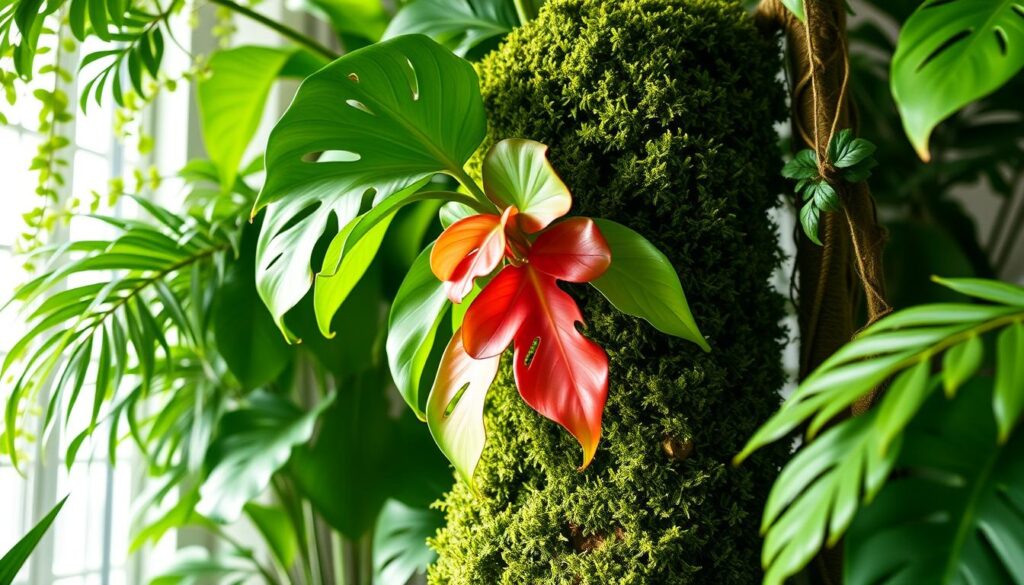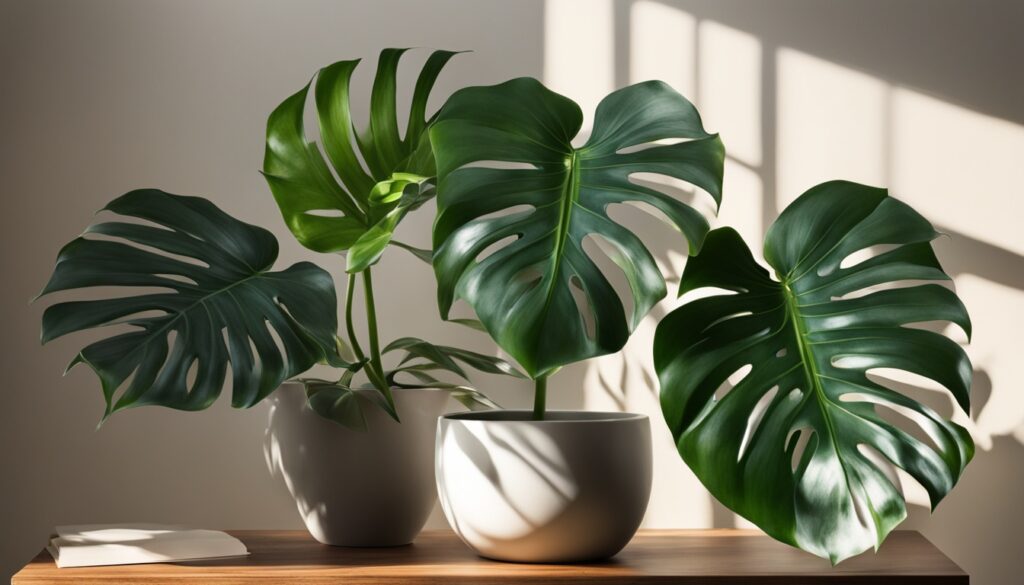Are you drawn to the Monstera plant’s unique Swiss cheese-like leaves? These tropical plants are becoming more popular. But, have you thought about why Monstera plants need climbing support and how to pick the best one? This guide will show you how to support your Monstera’s natural climbing and help it thrive.
Key Takeaways
- Monstera plants can grow up to 10 feet (3 meters) tall with the right support.
- Moss poles and coir poles help plants grow healthier and have bigger leaves.
- You can make your own moss pole with stakes, sphagnum moss, and coconut fiber.
- It’s important to secure the Monstera plant to the support pole for its growth and stability.
- Regular watering and misting of the support pole keep the moisture just right.
Understanding Monstera’s Natural Growth Habits
To understand why Monstera plants need the right support, we must know how they grow naturally. In the wild, Monstera deliciosa grows on trees in tropical rainforests of Mexico and Central America. These plants use aerial roots to climb up to 10 feet high.
Natural Climbing Behavior in the Wild
Monstera plants have a unique way of climbing in their natural habitat. They send out aerial roots to cling to trees, getting moisture and nutrients. This helps them reach sunlight and grow well in the rainforest.
The Role of Aerial Roots
Aerial roots are crucial for Monstera plants. They anchor the plant and help gather water and nutrients from the air. As the plant grows, these roots become stronger, helping it climb and thrive.
Growth Patterns and Development Stages
Monstera plants grow in a predictable way. They start with germination, which can take 7-21 days. After that, they go through a seedling stage and then a juvenile phase, growing new leaves each month.
As they mature, Monstera plants can grow up to 2 feet vertically or outward. Fenestrations, or “Swiss cheese” holes in leaves, appear within a year after germination.
| Growth Stage | Timeline | Key Characteristics |
|---|---|---|
| Germination | 7-21 days | Seeds sprout |
| Seedling | 1-3 months | Produces 1-2 new leaves per month |
| Juvenile | 6 months to 1 year | Fenestrations appear |
| Mature | 1 year+ | Vertical or outward growth up to 2 feet |
Knowing how Monstera plants grow naturally helps us see why they need the right support. This includes monstera aerial root support and natural monstera support to thrive at home.
Why Your Monstera Needs Climbing Support
Monstera plants are natural climbers, needing support like trees or rocks to grow. As houseplants, they need extra help to reach their full height. Without a support pole for monstera or climbing stake, they spread out more than they grow up.
The stems of Monstera plants can’t handle the weight of their big leaves as they get older. A support like a moss pole lets them grow up, making their leaves bigger and more interesting.
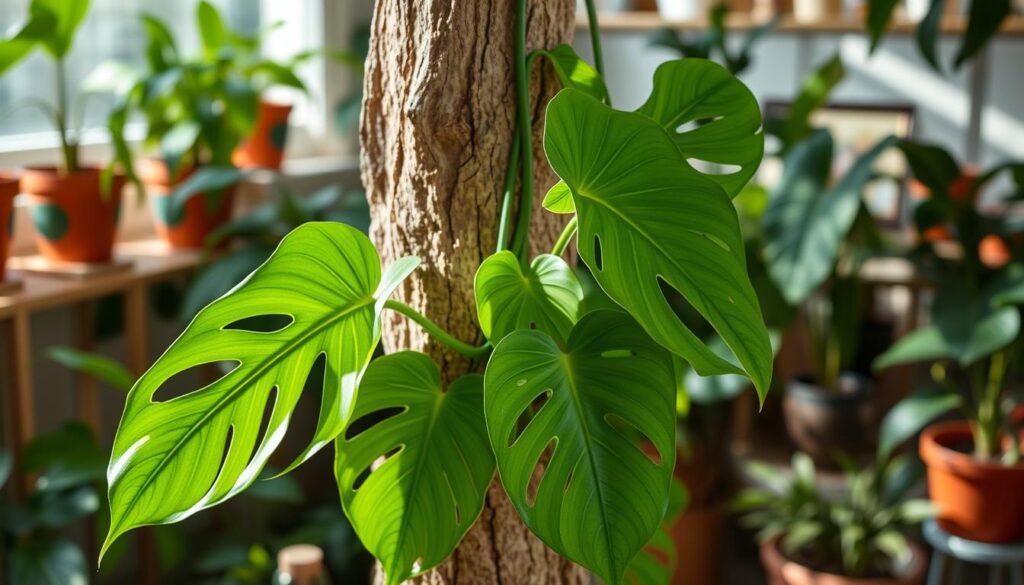
Using a strong support pole helps Monstera plants grow like they do in the wild. This makes them look better and use less space. Without support, they can become messy and hard to keep upright, needing more care.
Benefits of Using Support Pole for Monstera
Adding a support pole to your Monstera plant can greatly improve its growth and look. It helps the plant grow like it would in nature, leading to better leaf development and health. This also makes the most of your space.
Enhanced Leaf Development
Monstera plants grow bigger, more beautiful leaves when they have a support pole. This makes them look like they do in their natural habitat, climbing up trees.
Improved Plant Health
A support pole also boosts your Monstera’s health. It provides extra moisture and nutrients for the plant’s roots. This makes the plant stronger and more resilient.
Space-Efficient Growth
With a support pole, your Monstera can grow up instead of out. This saves space and makes your plant stand out.
Using a monstera moss pole or monstera coir pole can bring many benefits. It improves your plant’s look, health, and how it grows in a small space.
Types of Support Structures Available
Monsteras are majestic, climbing plants that thrive with the right support. Options range from moss poles to coir poles, bamboo canes to wire trellises. Moss poles and coir poles are favorites because they mimic tree bark and retain moisture.
Bamboo canes and U-shaped supports are versatile for different Monstera sizes and growth habits. These can be adjusted as the plant grows. Wire trellises are great for sprawling Monsteras or for creating unique shapes.
Moss Poles and Coir Poles
Moss poles and coir poles are top choices for Monsteras. They offer the perfect environment for aerial roots to thrive. Made from sphagnum moss or coir, they retain moisture and nutrients for healthy growth.
- Moss poles come in various sizes and heights, with bendable options for custom shapes.
- Coir poles are durable and eco-friendly, with a woven design that supports climbing.
Bamboo Canes and U-Shaped Supports
Bamboo canes and U-shaped supports are flexible for Monsteras with different growth habits. They can be adjusted to support the plant’s changing size and shape.
- Bamboo canes are sturdy and natural-looking, great for different configurations.
- U-shaped supports are secure and freestanding, perfect for strategic placement.
Wire Trellises
Wire trellises are ideal for sprawling Monsteras or for unique designs. They offer a durable, flexible framework that can be shaped to fit your plant’s growth and style.
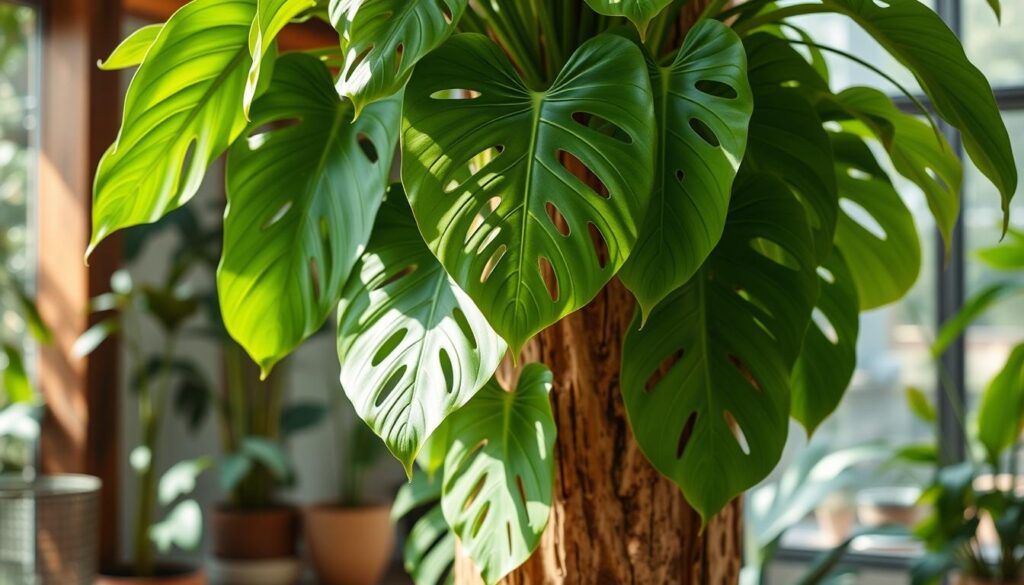
The right support structure for your Monstera depends on your preferences, the plant’s size and growth, and the look you want. With the right support, your Monstera will thrive and reach its full potential.
Moss Poles vs. Coir Poles: Choosing the Right Support
Choosing the right support for your monstera plant is important. Moss poles and coir poles have their own benefits. Knowing the differences helps you pick the best support for your plant.
Moisture Retention Properties
Moss poles, made from sphagnum moss, hold a lot of water. They can hold up to 20 times their dry weight in water. This creates a humid environment for your plant. But, they need more misting to keep the right moisture level.
Coir poles, made from coconut fiber, don’t dry out easily. They are a low-maintenance option.
Durability and Maintenance
Coir poles are more durable and last longer than moss poles. They need less care than moss poles, which may need to be replaced often. Wooden supports, like the Zella Trellis or Monstrella, are also durable and easy to care for.
Cost Comparison
Coir poles are cheaper and easier to find than moss poles. Moss poles can cost more because you need to buy sphagnum moss refills. This makes coir poles a better choice for many gardeners.
| Feature | Moss Poles | Coir Poles |
|---|---|---|
| Moisture Retention | Superior, up to 20x dry weight | Naturally resistant to drying out |
| Durability | Require more frequent replacement | More durable and resistant to decay |
| Maintenance | Need regular misting to stay moist | Require less maintenance |
| Cost | Higher due to moss refills | Generally more affordable |
Choosing between a monstera moss pole and a monstera coir pole depends on your needs. Both can support your climbing monstera well.
DIY Guide: Creating Your Own Moss Pole
Creating a moss pole for your monstera plant can boost its growth and look. This DIY project gives your plant the support it needs. It also makes your monstera look like it’s growing in the wild. With a few simple steps, you can make a moss pole that will help your monstera thrive.
Gather the Necessary Supplies
- A sturdy bamboo stake or wooden dowel
- Sphagnum moss or coconut fiber sheet
- Natural twine or biodegradable string
Prepare the Moss
Start by soaking the sphagnum moss or coconut fiber in water for about 15 minutes. This makes it easier to work with. After soaking, squeeze out extra water so the moss is damp but not wet.
Construct the Moss Pole
Place the bamboo stake or wooden dowel upright. Wrap handfuls of the prepared moss around the top two-thirds of the stake. Make a layer about 1 inch (2.5 cm) thick. Use natural twine or biodegradable string to hold the moss in place, wrapping it in a spiral pattern.
This moss pole is a budget-friendly and customizable way to support your monstera plant. It lets your monstera climb and grow in your home or garden.
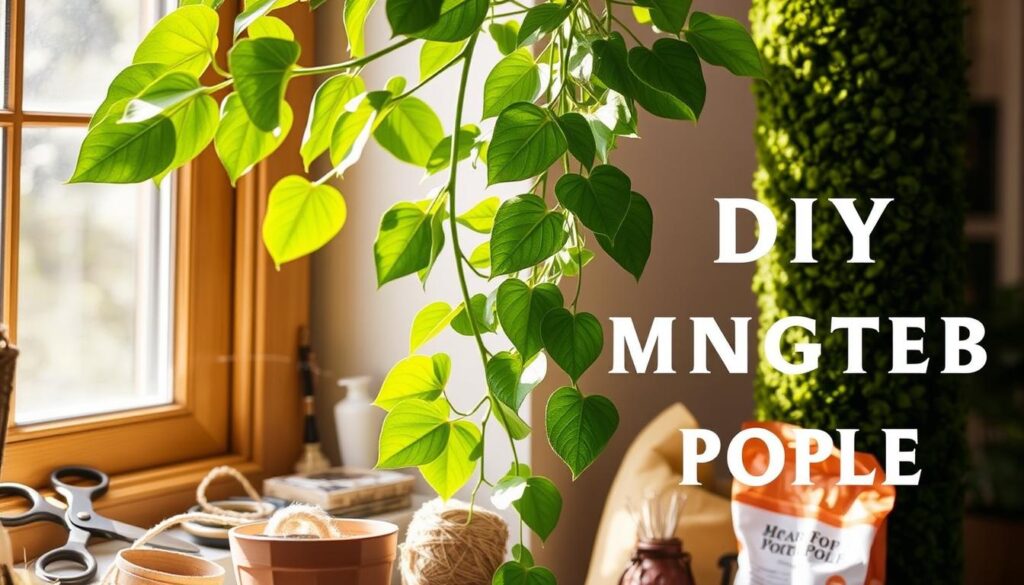
“Monsteras are natural climbers, and providing them with a moss pole encourages their growth and enhances their stunning foliage.”
By making your own monstera moss pole, you can meet your plant’s specific needs. This DIY moss pole project is a fun way to help your monstera grow. It also adds a beautiful touch to your plant collection.
Essential Materials for Support Installation
To set up a support pole for your monstera plant, you’ll need a few important items. First, you’ll need the monstera plant itself. You’ll also need a pre-formed monstera climbing stake or monstera plant totem. These can be made from moss, coir, or even 3D-printed designs.
Tools Required
- Trowel or small gardening shovel
- Gardening snips or wire cutters
- Gentle tie material (soft plant ties, yarn, or cotton string)
- Optional: Wooden peg or chopstick
If you’re repotting your monstera, get a new container that’s 1-2 inches wider than the old one. Also, choose high-quality potting soil for houseplants.
Support Materials List
The monstera climbing stake or monstera plant totem you pick depends on your plant’s needs and your preference. Here are some popular choices:
- Traditional moss poles
- Coir poles
- Wooden planks or trellises
- 3D-printed moss poles
Each material has its own advantages, like moisture retention, durability, and custom options. By picking the right support and following the installation steps, your monstera can thrive and grow to its full potential.
Step-by-Step Guide to Installing a Support Pole
It’s important to give your Monstera the right support for it to grow well. You can choose between a moss pole or a coir pole. The steps to install them are similar. Let’s go through them to help your Monstera thrive.
- Soak the moss pole or coir pole in water for at least 30 minutes. This makes it ready for installation.
- If you’re repotting your Monstera, remove it from its pot first. Check the roots and fix any problems. This is a good time to add the support pole.
- Put the plant a bit off-center in the pot. Leave space for the support pole to go behind it.
- Slide the moist pole behind the plant carefully. Make sure it’s stable and at the right height for your Monstera’s growth.
- Use soft ties or gardening tape to tie the main stems to the pole. This helps the plant climb and cling.
- Adjust the plant’s position to get the shape you want.
- Water the plant well and mist the pole often. This keeps the moisture up and helps the aerial roots grow.
Training your Monstera to climb takes time. It may take a while for it to adjust and start using the support. But with regular care, your Monstera will grow strong and show off its beautiful leaves.

By following this guide, you’ll help your Monstera grow well. It will become a beautiful, climbing plant that adds beauty to any room.
Training Your Monstera to Climb
To help your monstera plant grow, you need the right climbing support. Monstera deliciosa, or the Swiss cheese plant, grows fast and climbs naturally. By using a monstera climbing stake or natural monstera support, you can promote healthy growth and beautiful leaves.
To start, look for the thicker stems with aerial roots. Gently push these stems towards the support pole and tie them with soft ties or green tape. Let the smaller stems grow around the pole’s base. As time goes by, the aerial roots will cling to the pole, making a stunning display.
- Identify the thicker, more developed stems with aerial roots.
- Gently guide these stems towards the support pole.
- Secure the stems to the pole using soft ties or green gardening tape.
- Leave smaller leaf stalks free to grow around the bottom of the pole.
- Regularly mist the pole to encourage root growth and attachment.
Training your monstera to climb takes time. Not all plants will adapt right away. But with care and patience, your monstera will climb high, showing off its beautiful leaves.
“A moss totem is an upright pole covered in sphagnum moss that stakes directly into the pot with the plant, allowing it to behave more in line with its natural habitat.”
Moss poles, like the Mosser Lee’s Totem Pole™ Extendable Plant Supports, are great for monstera climbing stakes. They come in different lengths and can grow with your plant. Make sure to moisten the moss before setting it up to help the roots grow.
Proper Positioning and Attachment Methods
When securing your monstera plant to a support pole, use soft materials. Soft plant ties, yarn, or cotton string are good choices. They should hold the main stems at multiple points without being too tight.
Place the pole a bit behind the plant’s center. This lets the foliage grow outward. It also looks better.
For monstera plants in central spots, use crossed U-shaped canes. They offer support from all sides. This setup looks like a cage and helps the plant grow.
Securing Techniques
To attach your monstera to a monstera aerial root support or monstera plant totem, follow these steps:
- Use soft, non-abrasive ties like plant clips, velcro, or twine to gently secure the stems to the pole.
- Attach the plant at multiple points along the pole, ensuring even distribution of support.
- Avoid tying the stems too tightly, as this can restrict growth and cause damage.
- Regularly check the ties and adjust them as the plant grows to maintain proper support.
Optimal Placement Tips
Getting the right spot for your monstera support pole is key. Here are some tips:
- Position the pole slightly behind the plant’s center, allowing the foliage to face outward.
- For centrally located monstera plants, use crossed U-shaped canes to provide support visible from all sides.
- Ensure the pole is vertical and securely anchored to prevent it from becoming top-heavy as the plant grows.
- Monitor the plant’s growth and adjust the pole’s position as needed to accommodate its expanding size.
By using these attachment and positioning tips, your monstera will get the support it needs. It will thrive and show off its beautiful, tropical leaves.
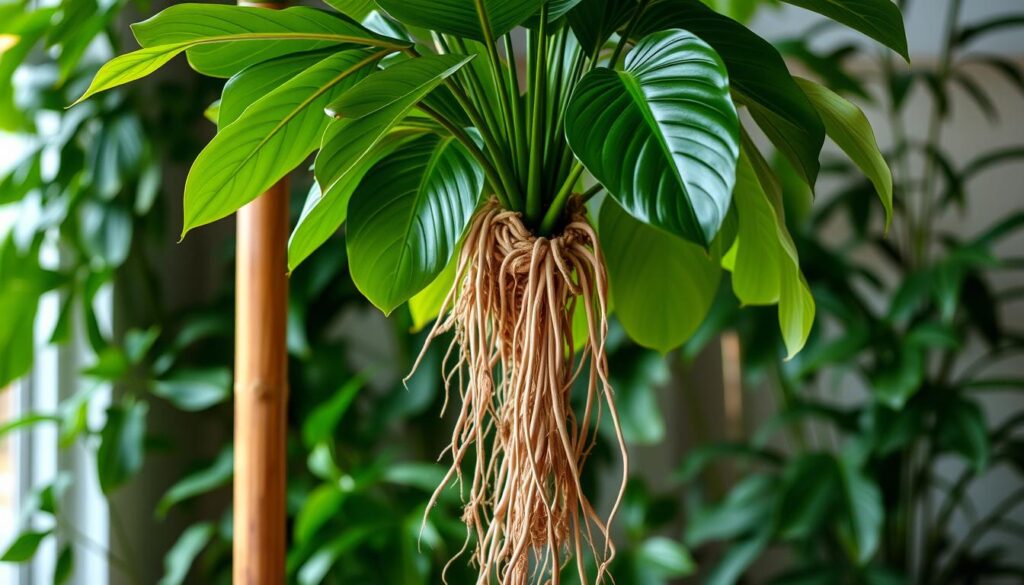
Maintenance of Support Structures
Keeping your monstera plant’s support structure in good shape is key for its health. Whether you use a monstera moss pole or a monstera coir pole, regular care is vital. This ensures your plant grows well.
It’s important to keep the moss or coir pole moist. Mist it often to help aerial roots grow. These roots will anchor your monstera and add stability. But, don’t overwater to avoid mold and other problems.
- Check the ties or clips holding your monstera to the support structure often. Adjust or replace them as your plant grows.
- Rotate the monstera now and then to promote even growth. This prevents it from becoming uneven.
- For moss poles, add more sphagnum moss as the old one breaks down.
- Coir poles are durable but might need cleaning sometimes to stop mold.
By regularly maintaining your monstera‘s support, you help it stay healthy. This lets your plant reach its full beauty and size.
Common Mistakes to Avoid
Proper installation and training are key for monsteras to do well with a support pole. Steer clear of these common mistakes to help your monstera climb successfully:
Installation Errors
- Not putting the pole deep enough in the pot, causing it to fall over.
- Wrapping ties too tight, which can hurt the monstera’s thin stems.
- Not misting the pole often, which stops aerial roots from growing.
Training Missteps
- Not following the plant’s natural climbing path when training it.
- Choosing the wrong support for your monstera’s size and growth.
- Not changing ties and supports as the plant grows, causing bad climbing.
Avoiding these mistakes helps your monstera climb well on the support pole. This promotes healthy leaf growth and overall plant health.
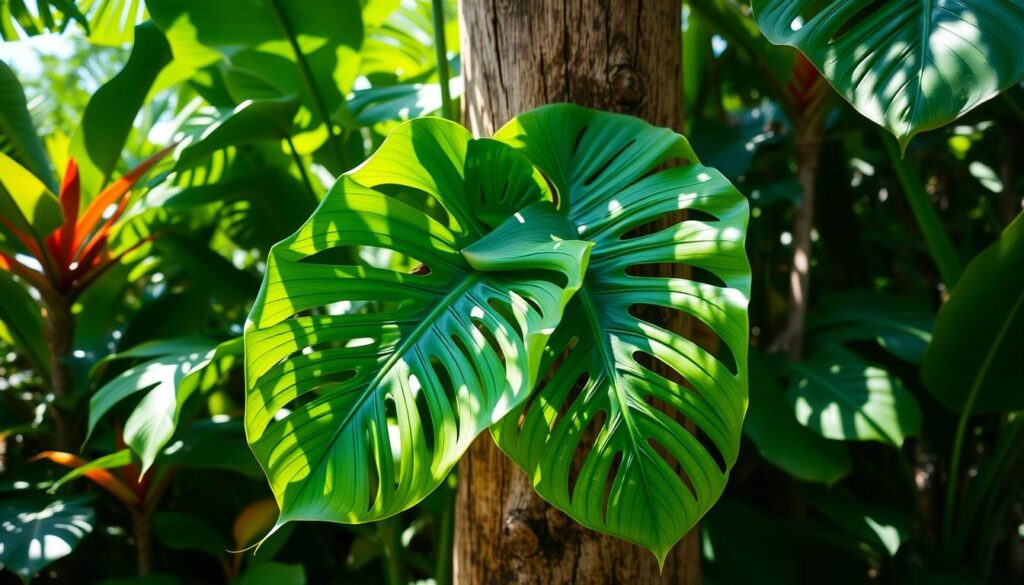
“Proper support and training are essential for monsteras to thrive and showcase their iconic split leaves.”
Repotting with Support Poles
Repotting your monstera plant with a support pole, like a monstera plant totem or monstera trellis, needs extra care. This is to keep the aerial roots safe. Follow these steps to repot your monstera and keep the support pole in place.
- Choose a new container that’s 1-2 inches bigger in diameter than the old one. Make sure it’s also deeper by several inches.
- Remove the plant and support pole from the old pot carefully. Keep the root ball together and avoid harming the aerial roots.
- Put the plant and pole in the new pot. Adjust the soil level to keep the pole stable and straight.
- Fill the gaps around the root ball with fresh, good-quality potting mix. Be gentle to avoid compacting the soil too much.
- Water the plant well until water comes out of the drainage holes. This shows the soil is moist enough.
Monstera plants usually need a new pot every two years for best growth and health. Repotting also helps prevent fungal root rot and bacterial infections.
“Proper positioning of the monstera with its back to the moss pole is crucial, as it allows for immediate attachment of the plant to the support structure, preventing growth issues.”
Repotting a monstera with a support pole can be easier with an extra pair of hands. Use elastic twine or rope to tie the plant to the pole. This helps avoid damaging the stem as it grows.
The main thing when repotting with support poles is to be gentle with the plant and its aerial roots. Keep the support pole stable and in the right position. By doing this, your monstera will keep growing and reaching new heights.
Troubleshooting Support Issues
Keeping your monstera aerial root support healthy is key for your plant’s growth. Natural monstera support is great, but sometimes you’ll face problems. Let’s look at some common issues and how to fix them.
Pole Instability
If your support pole wobbles, check if it’s deep enough in the soil. You might need to add pegs, chopsticks, or stake ties for more stability.
Stem Detachment
Stems can detach from the pole. Gently reattach them with soft ties or clips. Be careful not to hurt the aerial roots.
Uneven Growth
Uneven growth can happen if support is uneven. Rotate your plant and adjust the ties to help it grow evenly.
Aerial Root Attachment Issues
Problems with aerial roots attaching? Try increasing humidity and misting the pole more. This might help the roots stick better.
Fixing these issues will keep your monstera aerial root support working well. Your plant will grow strong and healthy.
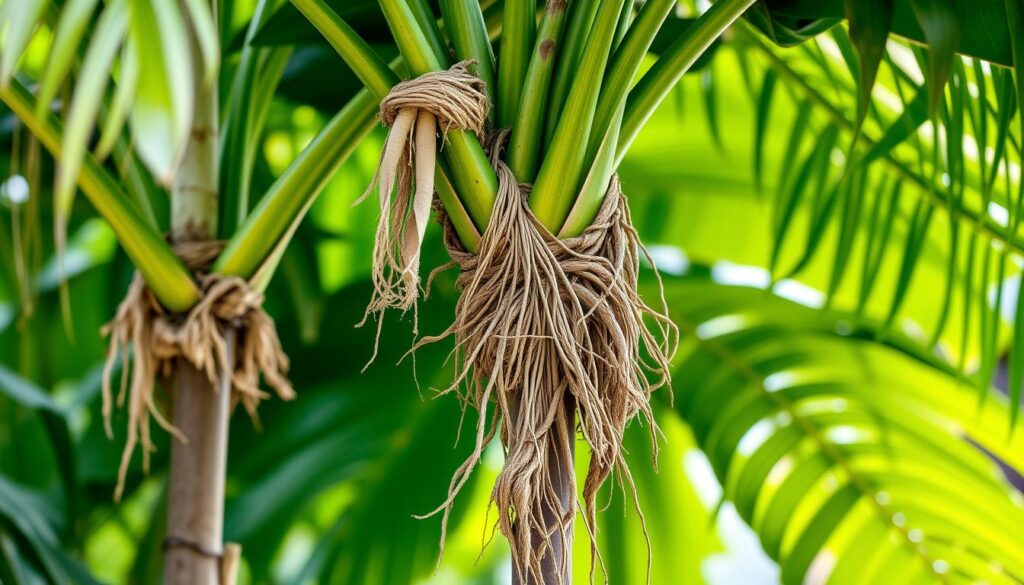
Advanced Care Tips for Climbing Monsteras
To help your climbing Monstera grow well, you need a good plan for feeding and trimming. Follow these tips to make your Monstera a lush, thriving plant.
Fertilization Schedule
Feed your Monstera monthly from spring to early fall with a balanced fertilizer. This supports its fast growth. In winter, when it grows slower, fertilize every 2-3 months.
Pruning Guidelines
Pruning keeps your Monstera bushy and looking good. Remove yellow or damaged leaves. Also, trim long aerial roots to keep it looking neat.
For new plants, cut stems with leaves and a node. Then, root them in water before planting in soil.
With a regular fertilization plan and pruning, your Monstera will stay healthy and vibrant. These tips will help it grow and flourish indoors.
